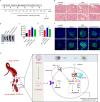MDSC-derived S100A8/9 contributes to lupus pathogenesis by promoting TLR7-mediated activation of macrophages and dendritic cells
- PMID: 38429401
- PMCID: PMC10907481
- DOI: 10.1007/s00018-024-05155-w
MDSC-derived S100A8/9 contributes to lupus pathogenesis by promoting TLR7-mediated activation of macrophages and dendritic cells
Abstract
Toll-like receptors (TLRs), especially TLR7, play an important role in systemic lupus erythematosus (SLE) pathogenesis. However, the regulatory mechanism underlying the abnormal activation of TLR pathways in patients with SLE has not been elucidated. Notably, accumulating evidence indicates that myeloid-derived suppressor cells (MDSCs) are important regulators of inflammation and autoimmune diseases. Compared with healthy control subjects, patients with SLE have a greater proportion of MDSCs among peripheral blood mononuclear cells (PBMCs); however, the effect of MDSCs on TLR7 pathway activation has not been determined. In the present study, lupus MDSCs significantly promoted TLR7 pathway activation in macrophages and dendritic cells (DCs), exacerbating the imiquimod-induced lupus model. RNA-sequencing analysis revealed significant overexpression of S100 calcium-binding protein A8 (S100A8) and S100A9 in MDSCs from diseased MRL/lpr mice. In vitro and in vivo studies demonstrated that S100A8/9 effectively promoted TLR7 pathway activation and that S100A8/9 deficiency reversed the promoting effect of MDSCs on TLR7 pathway activation in lupus. Mechanistically, MDSC-derived S100A8/9 upregulated interferon gamma (IFN-γ) secretion by macrophages and IFN-γ subsequently promoted TLR7 pathway activation in an autocrine manner. Taken together, these findings suggest that lupus MDSCs promote TLR7 pathway activation and lupus pathogenesis through the S100A8/9-IFN-γ axis. Our study identified an important target for SLE therapy.
Keywords: MDSCs; Macrophage; S100A8/9; SLE; TLR7.
© 2024. The Author(s).
Conflict of interest statement
The authors have no relevant financial or non-financial interests to disclose.
Figures







Similar articles
-
CD180 Ligation Inhibits TLR7- and TLR9-Mediated Activation of Macrophages and Dendritic Cells Through the Lyn-SHP-1/2 Axis in Murine Lupus.Front Immunol. 2018 Nov 15;9:2643. doi: 10.3389/fimmu.2018.02643. eCollection 2018. Front Immunol. 2018. PMID: 30498494 Free PMC article.
-
Granulocytic myeloid-derived suppressor cells contribute to IFN-I signaling activation of B cells and disease progression through the lncRNA NEAT1-BAFF axis in systemic lupus erythematosus.Biochim Biophys Acta Mol Basis Dis. 2020 Jan 1;1866(1):165554. doi: 10.1016/j.bbadis.2019.165554. Epub 2019 Sep 9. Biochim Biophys Acta Mol Basis Dis. 2020. PMID: 31513833
-
Pyruvate Kinase M2 Contributes to TLR-Mediated Inflammation and Autoimmunity by Promoting Pyk2 Activation.Front Immunol. 2021 May 7;12:680068. doi: 10.3389/fimmu.2021.680068. eCollection 2021. Front Immunol. 2021. PMID: 34025679 Free PMC article.
-
Human and Murine Toll-like Receptor-Driven Disease in Systemic Lupus Erythematosus.Int J Mol Sci. 2024 May 14;25(10):5351. doi: 10.3390/ijms25105351. Int J Mol Sci. 2024. PMID: 38791389 Free PMC article. Review.
-
The molecular underpinnings of female predominance in lupus.Trends Mol Med. 2025 May;31(5):438-451. doi: 10.1016/j.molmed.2024.11.002. Epub 2024 Dec 2. Trends Mol Med. 2025. PMID: 39627079 Review.
Cited by
-
S100A8/A9 Promotes Dendritic Cell-Mediated Th17 Cell Response in Sjögren's Dry Eye Disease by Regulating the Acod1/STAT3 Pathway.Invest Ophthalmol Vis Sci. 2025 Jan 2;66(1):35. doi: 10.1167/iovs.66.1.35. Invest Ophthalmol Vis Sci. 2025. PMID: 39808117 Free PMC article.
-
The role of multiomics in revealing the mechanism of skin repair and regeneration.Front Pharmacol. 2025 Jan 17;16:1497988. doi: 10.3389/fphar.2025.1497988. eCollection 2025. Front Pharmacol. 2025. PMID: 39896077 Free PMC article. Review.
-
Macrophages in inflammatory skin diseases and skin tumors.Front Immunol. 2024 Dec 5;15:1430825. doi: 10.3389/fimmu.2024.1430825. eCollection 2024. Front Immunol. 2024. PMID: 39703508 Free PMC article. Review.
-
FoxO1 Deficiency in Monocytic Myeloid-Derived Suppressor Cells Exacerbates B Cell Dysfunction in Systemic Lupus Erythematosus.Arthritis Rheumatol. 2025 Apr;77(4):423-438. doi: 10.1002/art.43046. Epub 2024 Nov 20. Arthritis Rheumatol. 2025. PMID: 39492682 Free PMC article.
References
MeSH terms
Substances
Grants and funding
LinkOut - more resources
Full Text Sources
Medical
Miscellaneous

